MORE FROM SCOTLAND MAGAZINE
Golf in St Andrews: Fife’s jewel in the crown
As The Open returns to the home of golf for its 150th anniversary, former student of the town, Henrietta Easton, explains the significance of golf in St Andrews
From 14-17 July 2022, the home of golf hosted the 150th Open at the world-famous Old Course at St Andrews. The world’s greatest players descended on Fife’s well-groomed town to try and claim the Claret Jug – the tournament’s trophy – and the pretty Scottish seaside town was abuzz with crowds of golf fans, novices and tourists alike.
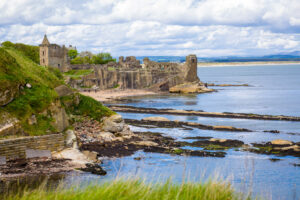
Golf in St Andrews
The first reference to golf in St Andrews was in 1552, but the game appears to have been around earlier than that, having evolved from a game played in the 15th century around St Andrews and Fife, when players would attempt to hit a pebble over sand dunes and around tracks using a bent stick or a club.
In fact, the sport became so popular that in 1457, with an invasion from the ‘auld enemy’ on the horizon, King James II was forced to ban the sport, as many Scotsmen were neglecting their military training in favour of a good old game of golf.
In 1502, the game gained the royal seal of approval when King James IV of Scotland became the world’s first golfing monarch. Thanks to this royal endorsement, the popularity of the game spread quickly, with King James VI of Scotland being the first to play golf in England, while his mother, Mary, Queen of Scots had introduced the game to France when she was studying. The common golf term ‘caddie’ actually derives from the name for Mary’s French military aides, known as cadets.
In 1754 the St Andrews Society of Golfers was formed to compete in its own annual golf competition, and the first ever 18-hole course was constructed at St Andrews in 1764, establishing the now recognised standard for the game. The club was honoured with the title ‘Royal and Ancient’ by King William IV in 1834, and the course was then established as the world’s premier golf club.
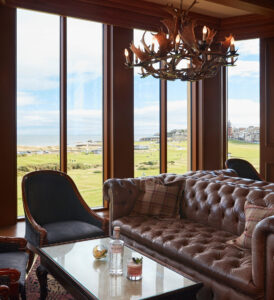
Although not the first course to host the Open Championships, which was held at Prestwick Golf Club in 1860, nowhere else has hosted the competition as many times as The Old Course at St Andrews, first doing so in 1873 and hosting it a record 28 times after that, most recently in 2015. The Old Course, as well as being iconic as the ‘home’ of golf, is also notorious for being difficult, as players are subject to Mother Nature’s wrath. Although the Open is held in the summer, Scottish weather can be unpredictable, and being almost on the beach, the course is particularly windy at times.
Visiting St Andrews
Although the sport is, rightly, ingrained into this wee town’s history, with golf shops and the dedicated R&A World Golf Museum, just metres from the course itself, there is plenty to enjoy for those not bothered by golf, too.
The pretty cobbled streets, idyllic fishing cottages, golden beaches and grand medieval architecture makes this town particularly picturesque and the perfect place to wile away an afternoon.
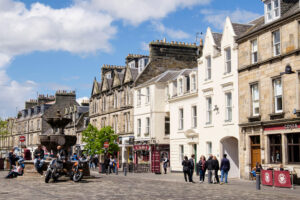
Credit: Realimage/Alamy.
St Andrew’s Cathedral
Named after St Andrew the Apostle, the town’s cathedral was built in 1158, and was once the centre of the medieval Catholic Church in Scotland. Although now in ruin thanks to the 16th-century Scottish Reformation, its dramatic positioning on the cliff overlooking the sea, and its turbulent history make it a must-see for your visit to the town.
Perched next to the cathedral on a rocky promontory overlooking a small, almost hidden beach, aptly named Castle Sands (where there is a tidal swimming pool that is perfect for a summer’s dip), St Andrew’s Castle completes the equation.
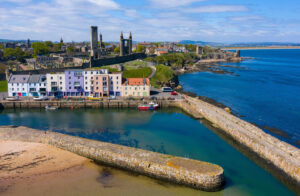
St Andrew’s Castle
Built towards the end of the 12th century to serve as a residence for the Bishops of Scotland, the castle has changed hands and fallen foul to many wars during its lifetime. When bishops were abolished in Scotland in 1592 the castle rapidly fell into ruin, and in 1801, the Great Hall collapsed and most of it plunged into the sea.
The ruins that remain are maintained by Historic Environment Scotland and visitors can walk what is left of the walls, and peak into the notorious dungeons. Its positioning makes it exceptionally beautiful, especially at sunset. If you’re into secrets and traditions, rumour has it that students will break into the castle walls after their annual Graduation Ball in June to watch the sunrise from the ruins.
University of St Andrews
The university is also worth a nosy around as it is famous for being the third oldest university in the English-speaking world, the oldest in Scotland and, of course, for sparking the romance between two popular young British royals.
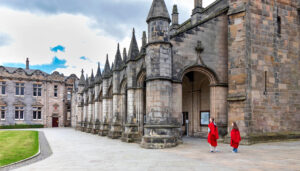
Founded in 1413, the beautiful and old university buildings are scattered throughout the town, with the medieval St Salvator’s Chapel and Quadrangle built between the coastal-facing road, The Scores, and the cobbled North Street, leading down to the cathedral. On a Sunday morning during term-time you might spot red-gowned figures walking along the precarious top path of the town’s pier, as the students take part in the traditional pier walk in their unique academic dress – this is quite a sight to see and it is worth giving it a go if you don’t mind heights.
Hidden in a courtyard on South Street behind some decadent wrought-iron gates, the university’s St Mary’s College, which houses the School of Divinity, is also an enticing spot to soak up some sunshine, and not well known by tourists. Sit on the grass under a beautiful tree supposedly planted by Mary, Queen of Scots herself.
St Andrews has a sense of individuality that you really don’t find anywhere else. Whether it’s the university buzz, the joy of a seaside town, the iconic medieval history, or its fame for being the home of golf, there truly is something for everyone.
In terms of this summer’s Open, golf fan or not, there was something magical about seeing the 150th anniversary of the championships played on the most famous course in the world, where the game itself was invented, 600 years ago.
Welcome to St Andrews.
Read more:

SCOTLAND MAGAZINE
Published six times a year, every issue of Scotland showcases its stunning landscapes and natural beauty, and delves deep into Scottish history. From mysterious clans and famous Scots (both past and present), to the hidden histories of the country’s greatest castles and houses, Scotland‘s pages brim with the soul and secrets of the country.
Scotland magazine captures the spirit of this wild and wonderful nation, explores its history and heritage and recommends great places to visit, so you feel at home here, wherever you are in the world.












